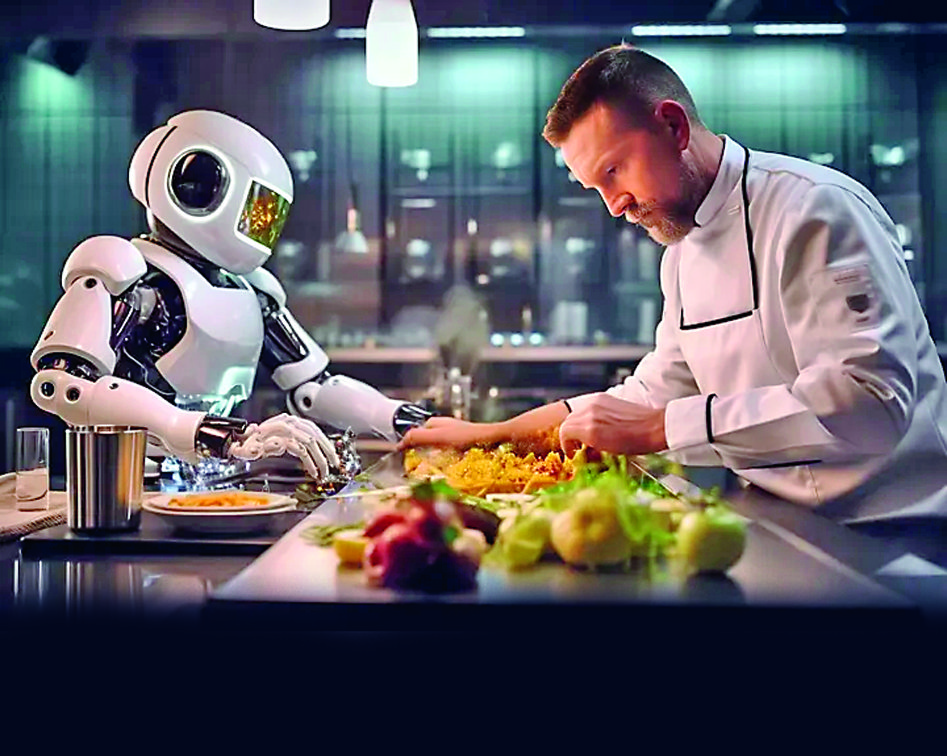Throwing a splash of colour and life into your dishes, tossing the ingredients and assortment of the staples in the air — is what makes cooking so deeply personal. But now, artificial intelligence (AI) is whipping up a storm in your kitchen. AI is slowly and steadily changing our kitchens, from sous chefs bringing in supplies to head chefs using virtual spatulas and creating future recipe ideas. People around the world are harnessing the culinary potential of AI to its fullest.
As technology marches forward, says Meet Shah, creative director, Gaurang’s kitchen, we find ourselves in a world where machines can replicate complex recipes, execute precision in plating, and even automate cooking tasks that once required a skilled hand. “Yet, the question persists: Can robots cook as well as humans? The answer lies not just in the method of preparation but in the heart behind the dish,” he points out.
Take a traditional Indian thali, for example — a platter of vibrant, aromatic curries, warm rotis, and perfectly spiced rice. “The ingredients may be simple, but each bite carries decades of tradition and the essence of generations,” he says.
According to Shah, his grandmother’s cooking was a reflection of love and care, with each ingredient serving a purpose and each technique handed down through stories.
He claims that his grandmother didn’t strictly adhere to recipes; instead, she used her senses of touch, smell, and taste to precisely adjust the spices or thicken the gravy. “That’s something a robot simply cannot do.”
Cooking is an art that goes beyond precision
“It’s about watching a simmering pot and knowing, without looking at a clock, when it’s just right. It’s about understanding that cooking for family is a way of sharing love, of nurturing others.”
A robot can replicate the steps of a recipe, but it cannot replicate the emotional connection, warmth, and memories woven into every dish, says Meet. “The way a grandmother’s hands move gracefully around the kitchen, the sound of the spices crackling in the pan — these things carry a depth and meaning that no machine can capture.”
He says the soul of a recipe doesn’t lie in its ingredients or technique alone, but in the spirit with which it’s prepared and served. “No matter how advanced the technology becomes, a machine cannot replace the human touch that makes cooking so deeply personal,” says Meet adding, “It’s the small imperfections, the adjustments made along the way, and the little secrets passed down over generations that truly make a dish come alive. That is the beauty of cooking, which no algorithm or robot can replicate.”
AI vs Michelin chef
AI vs. a two-Michelin-starred Valencian chef was the most popular cook-off at San Sebastian Gastronomika last month. Chef Ricard Camarena commanded one group, scientist Eneko Axpe the other. The challenge: cook using audience-suggested ingredients. Camarena’s appetiser and main course were lauded for their flavour and composition, whereas the AI-generated meals were technically outstanding but lacked character.
Sanjay Thumma, popularly known as Vah-Chef, says taste is deeply personal and cannot be universally standardised, especially when it comes to Indian food. “While recipes like pizza or burgers have gained global popularity through franchises and technology has successfully standardised many foods, such as bread, Indian cuisine remains unique,” says the Indian celebrity chef.
Every household in India has its own version of Rasam, Sambar, or chicken curry, modified by home cooks to suit their preferences —be it spice levels or flavours inherited through generations. “AI and technology can perfect consistency and achieve 90% satisfaction, but food lovers and connoisseurs often seek the extra 10% that only chefs can provide through personalisation,” he says.
The Human Touch: Chefs Think Beyond the Recipe!
Ajit Singh Garcha, Area GM, The Park Hyderabad, says we need to acknowledge the necessity of AI and robotics today to replace humans from mundane and repetitive jobs, its capability to be a precise workhorse. “It assists in reducing time to prepare and helps in safety and hygiene, to say the least. It optimises kitchen workflows to ensure timely delivery, elevating service quality.”
He says all this allows the chefs to focus on creating exquisite dishes, while the robot handles logistics flawlessly. “We must also see the limitations of AI; it lacks the emotional connection and creativity that the human chefs bring to the table,” he says.
Similarly, Dhruv Oberoi, Executive Chef, Olive Delhi, Olive Goa, and The Grammar Room says AI will never completely take over kitchens and bars. “Honestly, it shouldn’t. The human touch is the essence of every creative field, and no technology can replicate that. Cooking and mixology are rooted in emotions, intuition, and sentiment—things that go beyond calculations and algorithms,” he says.
While AI operates on data and logic, food and drinks connect people through stories, memories, and experiences.
“That said, technology can be an incredible tool when used wisely. AI can handle repetitive tasks, ensure precision, or even suggest innovative ideas, allowing chefs and bartenders to focus on creativity and artistry,” says Dhruv.

